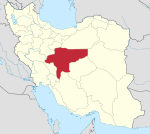| Hasht Behesht | |
|---|---|
 | |
 | |
| General information | |
| Architectural style | Iranian |
| Location | Isfahan, Iran |
| Coordinates | 32°39′12″N 51°40′13″E / 32.6534°N 51.6702°E |
Hasht Behesht or Hasht-Behesht (هشتبهشت, also romanized as Hašt-Behešt, lit. 'the Eight Heavens') is a 17th-century pavilion in Isfahan, Iran. It was built by order of Suleiman I, the eighth shah of Iran's Safavid Empire, and functioned mainly as a private pavilion.[1] It is located in Isfahan's famous Charbagh Street. It was also the first modern school in Isfahan was called His Majesty's School (Madrese Homayouni).[2][3]
YouTube Encyclopedic
-
1/2Views:3 4979 514
-
Mughal Architecture | Pishtaq | Hasht Bihisht | Pietra Dura | Double Dome | Taj Mahal | Charbagh
-
BAMIYAN KABUL AFGHANISTAN 1975
Transcription
Structure

As indicated on its name, the two-story pavilion of Hasht Behesht was built on the hasht-behesht plan, that is a type of floor plan consisting of a central hall surrounded by eight rooms.[4] The building is of an octagonal shape,[4] and has two main entrances. Four larger sides of it feature large balconies (iwans), under which some tall and thin wooden columns are raised.
The pavilion is decorated with mural paintings, perforated woodwork, prismatic mirrors, tilework, and plasterwork.[1][5]
Gallery
-
An 1840 drawing of Hasht Behesht by French artist Pascal Coste
-
Hasht Behesht seen from behind the pool
-
A room inside Hasht Behesht
-
Interior of a ceiling in Hasht Behesht
-
Interior of a ceiling in Hasht Behesht
-
Interior of a ceiling in Hasht Behesht
-
Interior of a ceiling in Hasht Behesht
-
An exterior view of Hasht Behesht
-
Hasht Behesht at night
See also
References
- ^ a b Babaie, Sussan; Haug, Robert (April 5, 2012). "Isfahan x. Monuments (2) Palaces". Encyclopædia Iranica. Vol. XIV. pp. 14–20. Archived from the original on May 26, 2020. Retrieved November 3, 2020.
- ^ "آنچه باید درباره مدارس نوین شهر اصفهان بدانیم - ایسنا". 2019-10-13. Archived from the original on 2019-10-13. Retrieved 2020-11-04.
- ^ "مدارس نوين در اصفهان از آغاز تا امروز (1)". rasekhoon.net. Retrieved 2020-11-04.
- ^ a b Bernardini, Michele (March 20, 2012). "HAŠT BEHEŠT (2)". Encyclopædia Iranica. Vol. XII. pp. 49–51. Archived from the original on January 7, 2019. Retrieved November 3, 2020.
- ^ "Hasht Behesht Palace". Lonely Planet. Archived from the original on 15 October 2018. Retrieved 15 October 2018.
Bibliography
- Wilber, D. N. (1962). Persian Gardens and Garden Pavilions. Tokyo. pp. 107–11.
{{cite book}}: CS1 maint: location missing publisher (link) - Ferrante, M. (1968). "Le Pavillon de Hašt Bihišt, ou les Huit Paradis, à Ispahan: Relevés et problèmes s'y rattachant'". In Zander, G. (ed.). Travaux de restauration de monuments historiques en Iran. Rome. pp. 399–420.
{{cite book}}: CS1 maint: location missing publisher (link)











